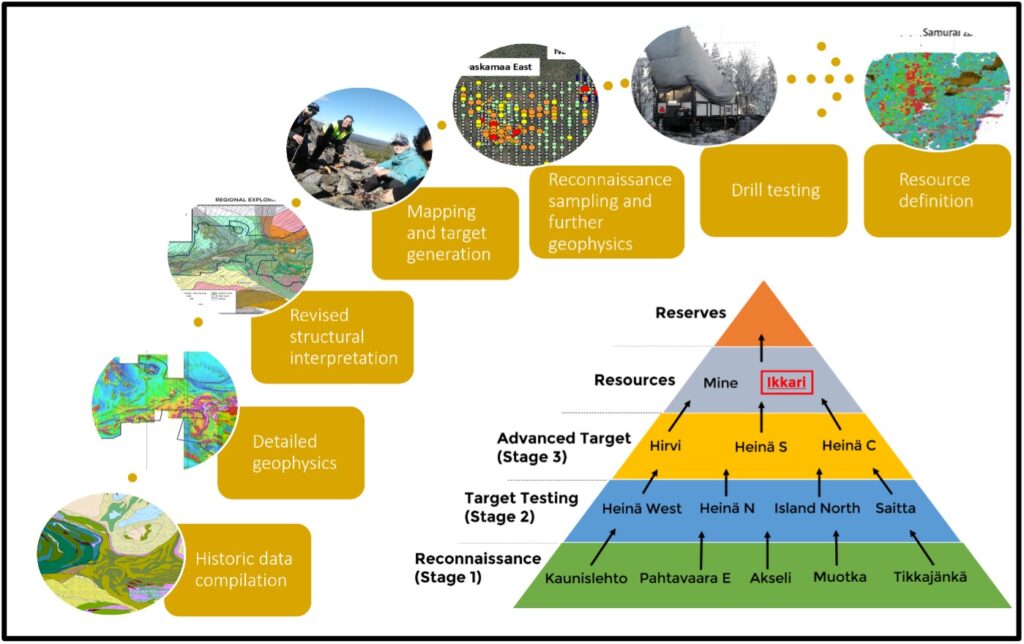ABOUT FINLAND
Finland has over a 100 years of mining heritage and a number of large mines. Rupert Resources’ primary focus is the Rupert Lapland Project in the Central Lapland Greenstone Belt in Northern Finland comprising the multi-million ounce Ikkari Discovery, permitted Pahtavaara mine and mill within a prospective land package.
REGIONAL SETTING AND INFRASTRUCTURE
The Rupert Lapland Project is located within the Central Lapland Greenstone Belt (CLGB), part of the Fennoscandian shield, which hosts 1700 known incidences of mineralisation in Finland, Sweden, Norway and Russia including around 80 mines. The CLGB has two gold mines of significance. Agnico Eagle’s Kittilä mine (the largest gold mine in Europe) which produced around 234,000oz of gold in 2023 and Pahtavaara which mined almost 450,000oz of gold over 16 years in three periods of ownership. Boliden’s copper-nickel Kevitsa mine and Anglo American’s Sakatti project are located within 30km of Rupert’s Pahtavaara mine.
The town of Sodankylä provides most of the support services for the Rupert Lapland Project including the use of an accredited assay laboratory. The regional industrial base is currently dominated by small businesses involved in forestry, agriculture and manufacturing. There are several hotels, shops, and restaurants which accommodate a growing year-round influx of tourists into Lapland. Two assay labs are also located in Sodankylä.
The town of Rovaniemi in Finland is located some 150 km south-southwest of Pahtavaara. Rovaniemi has a population of approximately 60,000 inhabitants and is the administrative centre of Finnish Lapland. The regional technical centre of the Geological Survey of Finland (GTK) and its analytical laboratory are also located here.
EXPLORATION HISTORY AND GEOLOGY
Following acquisition of the Rupert Lapland Project in 2016, Rupert undertook a comprehensive review of regional historical data resulting in a new geological model, which formed the basis of the work program that led to the discovery of the multi-million ounce Ikkari discovery, the first gold occurrence of scale to be delineated under cover.
In mid-2018 the company completed a re-appraisal of the regional geological setting of the Pahtavaara project and highlighted the prospectivity for hosting further orogenic gold deposits beyond the Pahtavaara mine. A detailed ground gravity survey over 200km2 of the licence, a new magnetic survey, detailed mapping, logging of historic drilling and over 15,000m of reconnaissance drilling resulted in the discovery of eight new gold occurrences.
Systematic exploration approach
HIGHLIGHTS FROM REGIONAL GEOLOGICAL STUDIES
Rupert Resources’ revised 2018 geological interpretation of the existing mine identified Pahtavaara as possessing a significantly larger footprint (up to 1,500m strike and 500m width) than previously considered. The regional setting was also shown to be comparable with deposits hosted in other greenstone belts including the Abitibi in Canada and Norseman-Wiluna in Western Australia. The Abitibi and Norseman Wiluna belts have each hosted over 100Moz of gold.

The 2018 structural studies also identified a 25km structural corridor between four distinct tectonostratigraphic domains, which likely acted as a regional fluid conduit, and has potential to host mineralisation, as demonstrated by the discoveries in Area 1.

The characterisation of multi-phase structural deformation, allowed targeting of reconnaissance exploration at prospective sites within the structural corridor. Area 1 gold occurrences, and associated sulphide breccias, appear to be controlled by a complex brittle-ductile permeability meshwork, developed by early thrusting and the interleaving of younger sediments with older ultramafics and mafic volcanics and volcanoclastics. Cross-cutting structural trends may have localised gold-bearing fluid flow.


